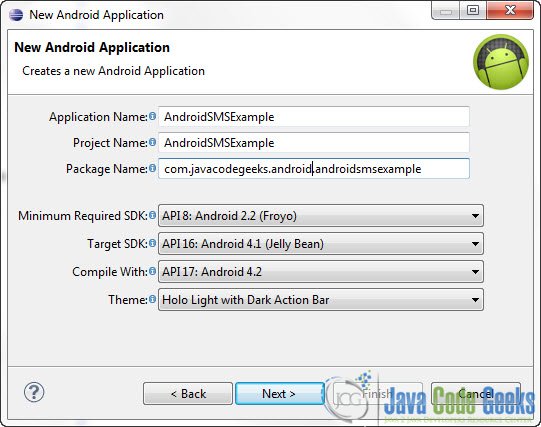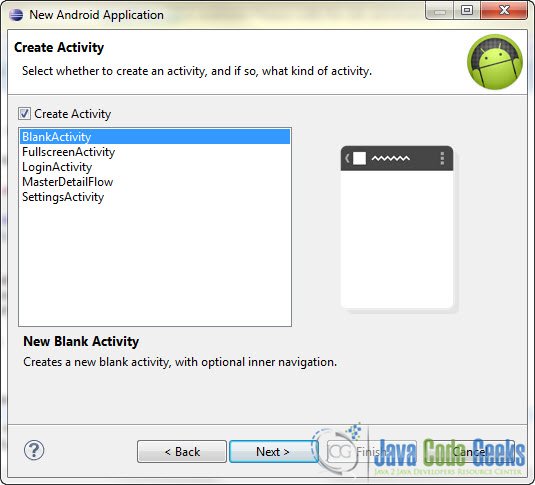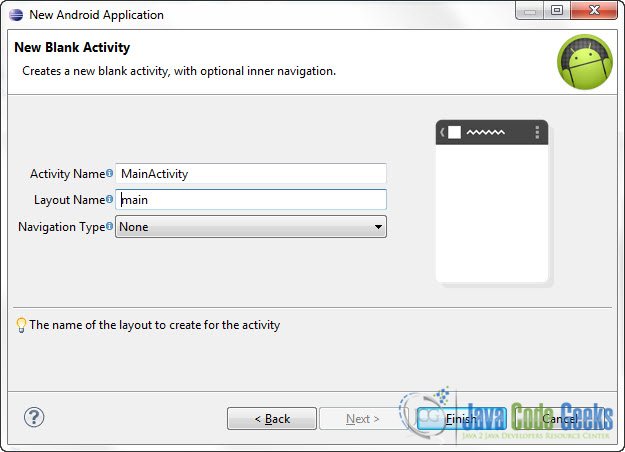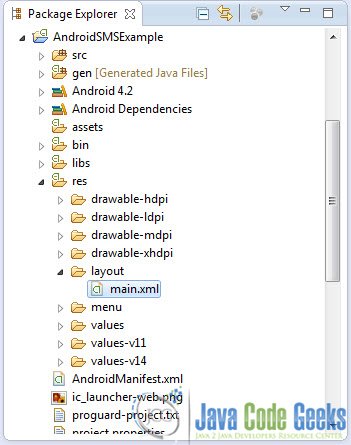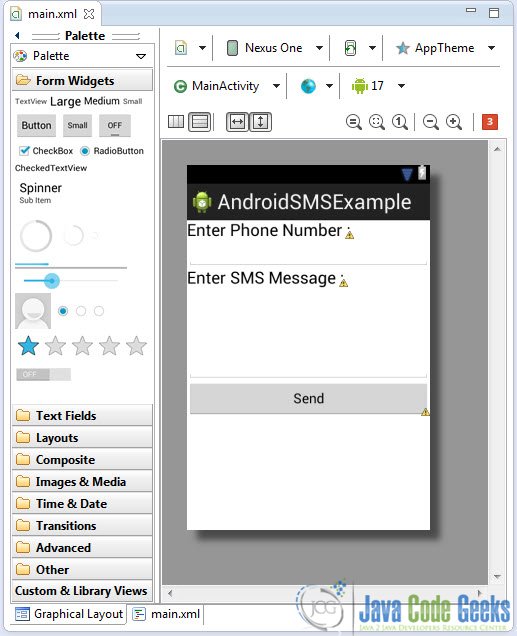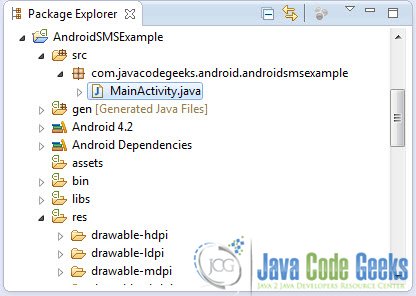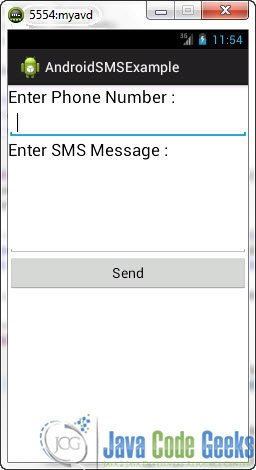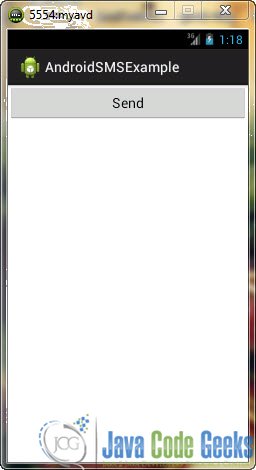Android: How to send SMS message
A very useful feature in Android is the SmsManager API which you can use to send an SMS from inside your own Application. Actually there are two way you can send an SMS from your Application:
- Using
SmsManagerAPI - Using the build in SMS activity of Android API
SmsManager API, you can customize your own Activity the way you want and use it in any manner you choose, so it’s much more flexible. So, in this tutorial we are going to examine both ways.For this tutorial, we will use the following tools in a Windows 64-bit platform:
- JDK 1.7
- Eclipse 4.2 Juno
- Android SKD 4.2
Create a new Android Project
Open Eclipse IDE and go to File -> New -> Project -> Android -> Android Application Project and click Next.
You have to specify the Application Name, the Project Name and the Package name in the appropriate text fields and then click Next.
In the next window make sure the “Create activity” option is selected in order to create a new activity for your project, and click Next. This is optional as you can create a new activity after creating the project, but you can do it all in one step.
Select “BlankActivity” and click Next.
You will be asked to specify some information about the new activity. In the Layout Name text field you have to specify the name of the file that will contain the layout description of your app. In our case the file res/layout/main.xml will be created. Then, click Finish.
Send an SMS using the SmsManager API
1. Create the main Layout of the Application
Open res/layout/main.xml file :
And paste the following code :
<?xml version="1.0" encoding="utf-8"?>
<LinearLayout xmlns:android="http://schemas.android.com/apk/res/android"
android:id="@+id/linearLayout1"
android:layout_width="fill_parent"
android:layout_height="fill_parent"
android:orientation="vertical" >
<TextView
android:id="@+id/phoneNum"
android:layout_width="wrap_content"
android:layout_height="wrap_content"
android:text="Enter Phone Number : "
android:textAppearance="?android:attr/textAppearanceLarge" />
<EditText
android:id="@+id/editPhoneNum"
android:layout_width="fill_parent"
android:layout_height="wrap_content"
android:inputType="phone" >
</EditText>
<TextView
android:id="@+id/SMSLabel"
android:layout_width="wrap_content"
android:layout_height="wrap_content"
android:text="Enter SMS Message : "
android:textAppearance="?android:attr/textAppearanceLarge" />
<EditText
android:id="@+id/editSMS"
android:layout_width="fill_parent"
android:layout_height="wrap_content"
android:inputType="textMultiLine"
android:lines="5"
android:gravity="top" />
<Button
android:id="@+id/button"
android:layout_width="fill_parent"
android:layout_height="wrap_content"
android:text="Send" />
</LinearLayout>Now you may open the Graphical layout editor to preview the User Interface you created:
2. Set the SMS Permissions in AndroidManifest.xml
Go to AndroidManifest.xml
And paste the following code in order to set the appropriate SMS permission for the Application:
<?xml version="1.0" encoding="utf-8"?>
<manifest xmlns:android="http://schemas.android.com/apk/res/android"
package="com.javacodegeeks.android.androidsmsexample"
android:versionCode="1"
android:versionName="1.0" >
<uses-sdk
android:minSdkVersion="8"
android:targetSdkVersion="16" />
<uses-permission android:name="android.permission.SEND_SMS" />
<application
android:allowBackup="true"
android:icon="@drawable/ic_launcher"
android:label="@string/app_name"
android:theme="@style/AppTheme" >
<activity
android:name="com.javacodegeeks.android.androidsmsexample.MainActivity"
android:label="@string/app_name" >
<intent-filter>
<action android:name="android.intent.action.MAIN" />
<category android:name="android.intent.category.LAUNCHER" />
</intent-filter>
</activity>
</application>
</manifest>3. Code
Go to the java file that contains the code of the activity you’ve just created:
And paste the following code:
package com.javacodegeeks.android.androidsmsexample;
import android.app.Activity;
import android.os.Bundle;
import android.telephony.SmsManager;
import android.view.View;
import android.view.View.OnClickListener;
import android.widget.Button;
import android.widget.EditText;
import android.widget.Toast;
public class MainActivity extends Activity {
Button button;
EditText editPhoneNum;
EditText editSMS;
@Override
public void onCreate(Bundle savedInstanceState) {
super.onCreate(savedInstanceState);
setContentView(R.layout.main);
button = (Button) findViewById(R.id.button);
editPhoneNum = (EditText) findViewById(R.id.editPhoneNum);
editSMS = (EditText) findViewById(R.id.editSMS);
button.setOnClickListener(new OnClickListener() {
@Override
public void onClick(View v) {
String phoneNo = editPhoneNum.getText().toString();
String sms = editSMS.getText().toString();
try {
SmsManager smsManager = SmsManager.getDefault();
smsManager.sendTextMessage(phoneNo, null, sms, null, null);
Toast.makeText(getApplicationContext(), "SMS Sent!",
Toast.LENGTH_LONG).show();
} catch (Exception e) {
Toast.makeText(getApplicationContext(),
"SMS faild, please try again later!",
Toast.LENGTH_LONG).show();
e.printStackTrace();
}
}
});
}
}4. Run the application
This is the main screen of our Application:
When you tap in the Phone Number, the numeric keypad pops up:
Now, when you tap in the SMS Message, the character keypad pops up:
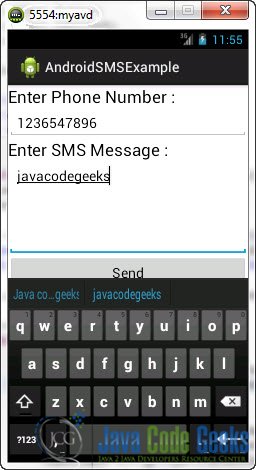
And if you press “Send”, your message will be sent in the number you specified. If not, a popup message will inform you about the mistake.
Download Eclipse Project
This was an Android SMS Example. Download the Eclipse Project of the first part of this tutorial: AndroidSMSExample_1.zip
Send an SMS using the Built-in SMS application
For this part you can go ahead and create a new Android Project if you want, but I’m just going to use the old one.
1. Create the main Layout of the Application
Open res/layout/main.xml file :
And paste the following code :
<?xml version="1.0" encoding="utf-8"?>
<LinearLayout xmlns:android="http://schemas.android.com/apk/res/android"
android:id="@+id/linearLayout1"
android:layout_width="fill_parent"
android:layout_height="fill_parent"
android:orientation="vertical" >
<Button
android:id="@+id/button"
android:layout_width="fill_parent"
android:layout_height="wrap_content"
android:text="Send" />
</LinearLayout>2. Code
Go to the java file that contains the code of the activity you’ve just created:
And paste the following code:
package com.javacodegeeks.android.androidsmsexample;
import android.app.Activity;
import android.content.Intent;
import android.os.Bundle;
import android.view.View;
import android.view.View.OnClickListener;
import android.widget.Button;
import android.widget.Toast;
public class MainActivity extends Activity {
Button button;
@Override
public void onCreate(Bundle savedInstanceState) {
super.onCreate(savedInstanceState);
setContentView(R.layout.main);
button = (Button) findViewById(R.id.button);
button.setOnClickListener(new OnClickListener() {
@Override
public void onClick(View v) {
try {
Intent smsIntent = new Intent(Intent.ACTION_VIEW);
smsIntent.putExtra("sms_body", "JavaCodeGeeks");
smsIntent.setType("vnd.android-dir/mms-sms");
startActivity(smsIntent);
} catch (Exception e) {
Toast.makeText(getApplicationContext(), "SMS faild!",
Toast.LENGTH_LONG).show();
e.printStackTrace();
}
}
});
}
}As you can see when the “Send” button is clicked, the build in SMS Activity will be launched.
3. Run the application
This is the main screen of our Application:
When you press Send, a new Activity will be launched:
Download Eclipse Project
This was an Android SMS Example. Download the Eclipse Project of the first part of this tutorial: AndroidSMSExample_2.zip


